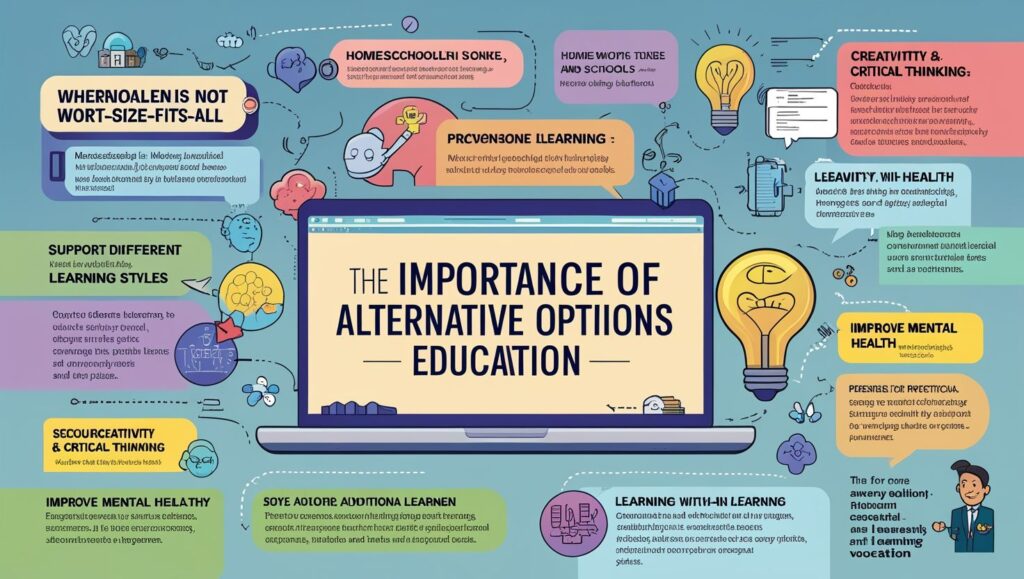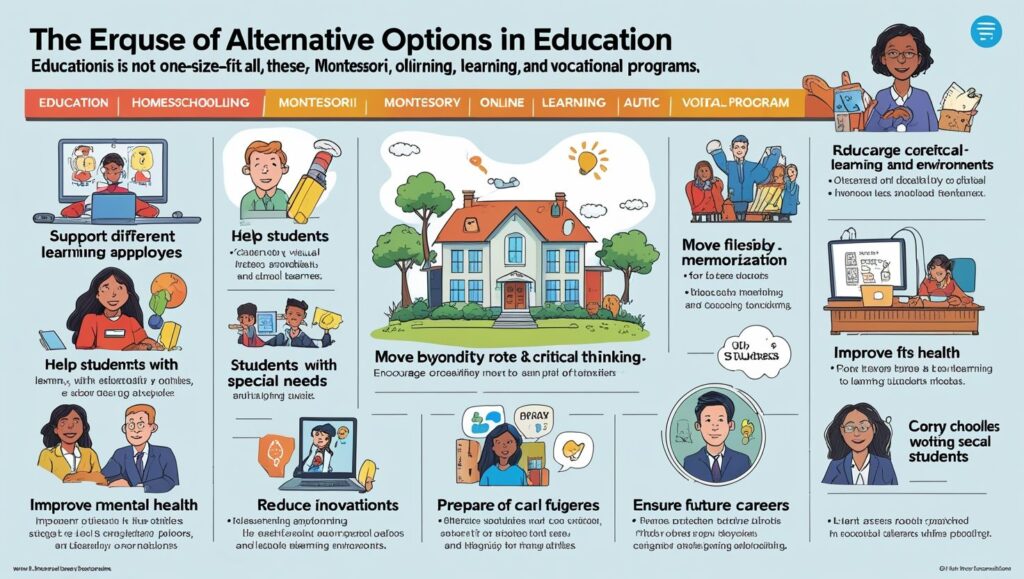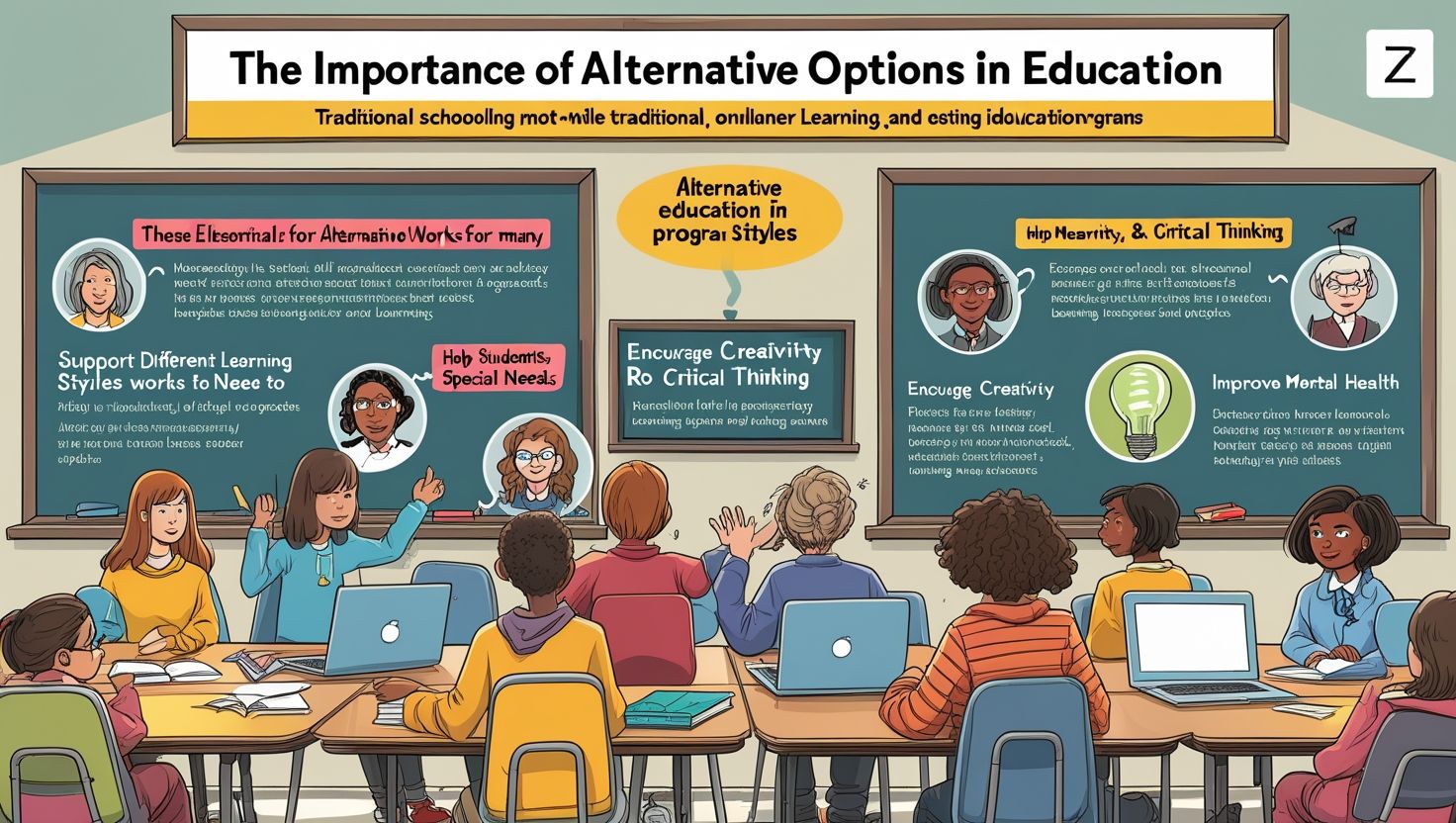Introduction
The Importance of Alternative Options in Education, Education is the foundation of personal and societal development, shaping individuals’ minds and preparing them for future challenges. However, traditional education systems—often centered around standardized curricula, rigid teaching methods, and uniform assessment techniques—do not cater to the diverse needs of all learners. This limitation has led to the growing recognition of alternative education options, which provide flexible, personalized, and innovative approaches to learning.
Alternative education encompasses a wide range of models, including homeschooling, Montessori schools, Waldorf education, online learning, vocational training, and experiential learning programs. These options are crucial because they address different learning styles, accommodate students with functional needs, and offer solutions for those who struggle in conventional settings. This article explores why alternative educational options are essential, highlighting their benefits for students, educators, and society as a whole.
1. Catering to Diverse Learning Styles
One of the most significant advantages of alternative education is its ability to accommodate different learning styles. Traditional schools often follow a one-size-fits-all approach, emphasizing rote memorization and standardized testing. However, students learn in various ways—some are visual learners, others are auditory or kinesthetic learners, and many thrive in hands-on environments.
Examples of Alternative Approaches:
- Montessori Education: Focuses on self-directed learning, allowing students to explore subjects at their own pace.
- Waldorf Schools: Emphasize creativity, imagination, and holistic development rather than rigid academic structures.
- Project-Based Learning (PBL): Encourages students to learn through real-world projects, fostering critical thinking and problem-solving skills.
By offering diverse methodologies, alternative education ensures that students who may struggle in traditional classrooms can still achieve academic success.
2. Supporting Students with functional
Many students with learning disabilities, ADHD, autism, or othersupportive needs find traditional schooling environments challenging. Standardized teaching methods may not provide the necessary accommodations, leading to frustration, disengagement, and poor academic performance.
Alternative education models, such as specialized schools or individualized learning plans, offer tailored support. For example:
- Inclusive Classrooms: Some alternative schools integrate students with disabilities into mainstream classes while providing additional support.
- Therapeutic Schools: These institutions focus on emotional and psychological well-being alongside academics, helping students with behavioral challenges.
- Homeschooling: Parents can customize lessons to suit their child’s pace and learning style, ensuring better comprehension and retention.
By embracing flexibility, alternative education ensures that all students, regardless of their challenges, have access to quality learning experiences.

3. Encouraging Creativity and Critical Thinking
Traditional education systems often prioritize conformity over creativity. Standardized testing and rigid curricula can stifle innovation, discouraging students from thinking outside the box. Alternative education, on the other hand, fosters creativity and independent thought.
How Alternative Education Promotes Creativity:
- Arts-Integrated Learning: Schools like Waldorf and Reggio Emilia emphasize artistic expression as a core part of education.
- Experiential Learning: Programs that involve internships, field trips, and hands-on activities help students apply knowledge in real-world contexts.
- Student-Centered Learning: Approaches like democratic schooling allow students to choose their subjects, encouraging curiosity and self-motivation.
When students are encouraged to explore and innovate, they develop problem-solving skills that are essential for future careers in a rapidly changing world.
4. Addressing Mental Health and Well-being
The pressure to perform in traditional schooling systems has led to rising levels of stress, anxiety, and depression among students. High-stakes testing, excessive homework, and rigid schedules contribute to burnout, particularly in high-achieving students.
Alternative education models prioritize mental health by:
- Reducing Academic Pressure: Some schools eliminate grades and standardized tests, focusing instead on mastery and personal growth.
- Incorporating Mindfulness Practices: Many alternative schools integrate meditation, yoga, and emotional intelligence training into their curricula.
- Offering Flexible Schedules: Online and hybrid learning options allow students to learn at their own pace, reducing stress.
By fostering a healthier learning environment, alternative education helps students develop resilience and emotional well-being.
5. Preparing Students for the Future Workforce
The job market is evolving rapidly, with automation, artificial intelligence, and globalization reshaping industries. Traditional education, which often emphasizes memorization over practical skills, may not adequately prepare students for these changes.
Alternative education bridges this gap by:
- Emphasizing Vocational Training: Trade schools and apprenticeship programs provide hands-on experience in fields like engineering, healthcare, and skilled trades.
- Teaching Digital Literacy: Online courses and coding boot camps equip students with tech skills needed in the digital economy.
- Developing Soft Skills: Collaborative and project-based learning models enhance communication, teamwork, and adaptability—skills highly valued by employers.
As the demand for adaptable, skilled workers grows, alternative education ensures students are better prepared for future careers.

6. Providing Solutions for Non-Traditional Learners
Not all students thrive in conventional school settings. Some may face challenges such as:
- Bullying or Social Anxiety: Alternative schools often have smaller class sizes and more supportive environments.
- Family Responsibilities or Work Commitments: Online and night schools allow students to balance education with other obligations.
- Geographical Barriers: Rural students can access quality education through virtual learning platforms.
By offering flexible and inclusive options, alternative education ensures that no student is left behind due to circumstances beyond their control.
7. Encouraging Lifelong Learning
Traditional education often treats learning as a finite process that ends with graduation. However, in today’s fast-paced world, continuous learning is essential for personal and professional growth.
Alternative education models promote lifelong learning by:
- Encouraging Self-Directed Education: Homeschooling and unschooling foster a love for learning beyond formal schooling.
- Providing Adult Education Programs: Community colleges, online courses, and certification programs allow individuals to upskill at any age.
- Offering Micro-Credentials: Short-term courses and digital badges enable professionals to stay updated in their fields.
This shift from a fixed mindset to a growth mindset ensures that individuals remain adaptable and knowledgeable throughout their lives.
8. Promoting Equity and Accessibility
Traditional education systems often favor students from privileged backgrounds, leaving marginalized groups at a disadvantage. Alternative education can help bridge this gap by:
- Reducing Costs: Online courses and open educational resources (OER) make learning more affordable.
- Supporting Underserved Communities: Charter schools and community-based programs provide quality education in low-income areas.
- Offering Multilingual Education: Some alternative schools cater to immigrant students by providing instruction in their native languages.
By increasing access to education, alternative models contribute to a more equitable society.
Conclusion
Alternative education is not just a supplementary option—it is a necessary evolution in how we approach learning. By embracing these principles, alternative education unlocks potential and creates pathways to success for all. Moreover, as the world changes, so must our education systems. Alternative models prepare students for future workforce demands, promote lifelong learning, and enhance accessibility for all. While traditional education will always have its place, embracing alternative options is essential for creating a more inclusive, adaptable, and effective learning environment.
The future of education lies in diversity—not just in student populations, but in the ways we teach and learn. By valuing and expanding alternative education, we can build a system that truly serves every learner.

5 thoughts on “The Importance of Alternative Options in Education”
Comments are closed.